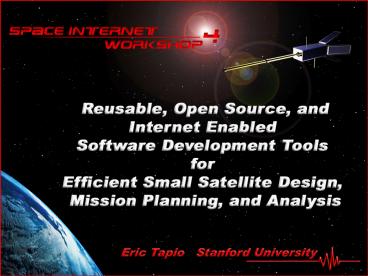The Pursuit for Efficient SC Design - PowerPoint PPT Presentation
1 / 10
Title:
The Pursuit for Efficient SC Design
Description:
... communication and interaction between designers and customer regarding ... Drive power subsystem hardware in baseline scenario simulation ... – PowerPoint PPT presentation
Number of Views:13
Avg rating:3.0/5.0
Title: The Pursuit for Efficient SC Design
1
(No Transcript)
2
The Pursuit for Efficient S/C Design
- The Stanford Small Sat Challenge
- Learn system engineering processes
- Design, build, test, and fly a CubeSat project
- Goal Initial design to final completion in one
year - Accomplish goal by
- Use of COTS parts
- Implement efficient design development
processes with currently available technologies - Project Constraints
- Limited Resources Small Teams
- Low Cost
- Small Physical Size Standard CubeSat 10 x 10 x
10 cm, 1kg - Experienced Risks Resulting in Project Failure
- No.1 Risk Ineffective communication and
interaction between designers and customer
regarding requirements and payload specifications
during design and early development phases
3
Success Story The QuakeSat Project
- QuakeSat
- Stanfords 3rd lightest (9 lb.) small satellite
launched - 1.5 years initial design to completion launch
- Anticipated 6 month mission
- Launched June 30th 2003, and still operating
- Design Challenges Process Inefficiencies
- Biggest inefficiencies were in Design phase
- Whats our baseline design, and our expected
power? - Do we have power margin?
- Biggest Challenges were related to lack of
infrastructure to evaluate
design - No significant leverage off previously developed
analysis tools - Only time for one evolving design solution
- Required significant parallel development of
infrastructure - Bottom Line Better integrated analysis tools are
needed upfront - Biggest Lesson A completed satellite helps, but
much more is necessary to achieve mission
readiness, and mission success
4
An Improved Paradigm
- The Desired Goal Enable transparent end-to-end
network communications among space mission
resources - A necessity after spacecraft deployment
- But also critical throughout the S/C design
development lifecycle - Start with a mission-centric architecture
starting from the design stage with networked
TCP/IP solutions - Enable communication between design team,
developers, customer, operators, mission planners - During 90 of the design and development phase,
QuakeSat team members worked independently from
separate geographical locations - Target Lifecycle Reusable Tools and Incremental
Development - Build a satellite, co-develop mission essential
tools - Use IP enabled ground stations (Stanford Mercury
GS, J. Cutler) - Develop mission tools that work seamlessly with
GS for mission data, information visualization,
and data dissemination
5
Better SW Tools - One Approach
- Utilize and Interface Software COTS programs
- Leverage off of existing COTS capabilities
- STK Scenario and Orbit Propagation Tools
- Matlab scientific computing and hardware
interfacing capability - National Instruments Data Socket Technology
- The Internet, web servers, HTML, XML
- Enable Spacecraft design with simple core
components - Laptop/ PC, Internet Connection, LabJack USB
Device - Enables end users to
- Run scenario simulations
- Perform mission utility analysis
- Evaluate design performance parameters
- Affect hardware for system and subsystem tests
- Hardware interaction across the Web
- Data resource sharing
6
Team Architecture
Customer
Operations / Planning
User
Designer
Satellite Development Lab
Designer
7
S/C Solar Power Performance
- Solar Power Performance Parameters tool
- For small satellites in particular, power is a
driving design constraint - Utilize reusable tool, run different design
models in an STK scenario - Output model power analysis
- Incorporate 3D-visualization, helpful for designs
w/ complex geometry - Drive power subsystem hardware in baseline
scenario simulation - Enable tool so that satellite design teams have
access via Internet - QuakeSat Power Performance Design Testing
- Took 1.5 months to modify an Matlab simulation
with our design specifics, and it did not easily
accommodate alternative designs - Testing power subsystem HW in early development
phase, invaluable - Change of requirements Near end of development,
change in orbit, equatorial to sun-synchronous,
and change in attitude profile. Whats the
expected impact on power? - Change scenario definition in STK, and rerun
8
S/C Solar Power Performance Demo
- All quaternion and vector data generated by STK
- QuakeSat model is given
- Spinning constraint
- 1.1/sec about Z- Inertial
- Sun Vector, shown in Yellow
- Based on the panel-sun geometry, expected
- power for each solar panel is plotted
- The net input power is calculated
- Power conversion model outputs a voltage
- to drive HW
9
Findings, Conclusions Trends
- By utilizing COTS parts and available
technologies, small sats CubeSats are a cost
efficient platform for conducting short
scientific missions in space - With development of better integrated design
tools, small satellite design and development can
be a more efficient process - With appreciable time savings in using reusable
software design tools, goal of making small
satellite design to flight time in one year a
consistent and repeatable process is obtainable - The development of reusable, open source, S/C
design and development tools are crucial
infrastructure needed, and provides a helpful
starting point for new teams - TCP/IP enabled design tools that enable
end-to-end communication may be effective in
mitigating No. 1 risk preventing project
completion - Small satellite projects mimic all the
complexities that their larger counterpart
projects face. So leverage off the low cost of
implementing new ideas on small satellites, and
scale up to improve current processes used for
design on larger projects
10
For More Information































